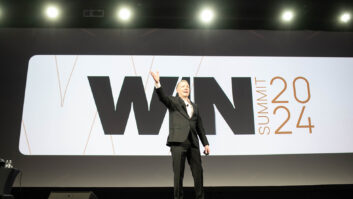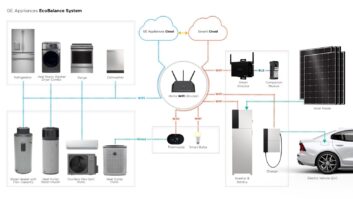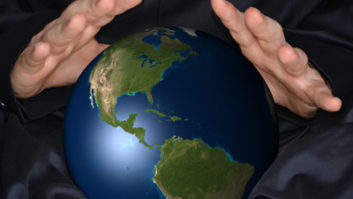Dana Point, Calif. — Three top executives from LG, Panasonic and Sony mostly agreed on issues facing the CE industry during a panel this morning at the Consumer Electronics Association’s (CEA) annual CEO Summit, held here this week.
LG Electronics president/CEO Michael Ahn, Panasonic chairman/CEO Yoshi Yamada and Sony Electronics
president/COO Stan Glasgow agreed for the most part on retail sales, recycling and energy use, free trade and other key issues facing the industry, in a panel moderated by CEA president/CEO Gary Shapiro.
Economic conditions and retail sales topped the list of issues discussed. When asked about current market conditions for CE and the future, Yamada and Ahn seemed to agree with Glasgow taking a longer and more conservative view.
“Certainly recently, thanks to the digital TV convergence, we have started to see some encouraging signs of recovery in the past 60 days. [But] we are not there yet.”
Ahn noted, “Everyone agrees that recovery will take longer than in past [recessions] and I agree. But the CE industry, with HDTV, Blu ray and set-top boxes, we are in a better position than other industries. TV sales have been up [in double digits] in the second quarter.” With the coming vacation season, “maybe people won’t take a trip, stay home and buy a TV for entertainment.”
Glasgow agreed that there are “positive signs” in the market now, but stated, “I think it will take a long time [to recover] worldwide and in the U.S. I don’t think [the market] will be back the way it was before the recession. This is a new era with new challenges for value creation. I don’t see growth rates we have seen in the recent past” coming back in the foreseeable future.
However, for the short-term, Glasgow said he sees a good sign. “Camcorders are the ‘canary in the coal mine.’
We have seen tremendous activity there, which usually means consumers are spending to prepare for a big family event or vacations.”
When asked if the U.S. will remain the most important market for the CE industry in the future, all three execs agreed that while China, India, Brazil and Europe may grow faster in coming years, this country will retain a leadership role.
“The U.S. is the most creative and trend-setting market, which is why we focus on it. That’s why we do more R&D here, for this market, since consumers are more creative and demanding,” Glasgow said.
Yamada agreed, adding, “The U.S. is the biggest market and will be the most influential in CE 10 years down the road … due to its lifestyle, standards and creativity … not only the size of the market.”
When asked by Shapiro about the general U.S. economy and whether or not the recession will have long-range effects on CE spending, Ahn said, “U.S. consumers did not save much in the past. Since the beginning of the year, savings have improved. U.S. [private] and government debt is being financed by other countries. The U.S. should reduce its borrowing and cut its deficit or else” this type of economic crisis could return.
Glasgow noted that the recession and economic downturn has created “permanent changes in the U.S. economy. Deficits will not disappear in three years … to deal with what happened in the past several years.”
In terms of how this may change CE purchases, Yamada said a change in U.S. consumer behavior is the key. “There are two extremes — consumers could turn to commodity products and pricing, or will look for value and innovation in technology.”
Glasgow said he didn’t know if a consumer shift to value-based products would be “permanent,” but he noted, “We have to do more than offer a ‘good, better, best’ strategy. We see it, based on our demographic studies to offer a ‘crown’ of product features for specific [consumer] segments.”
Shapiro asked about the effect of Circuit City’s demise on the industry and all agreed with Yamada’s comments that “it was unfortunate … and bad for the industry.”
However, Glasgow said, “I agree, but Circuit was not the first retailer to go out of the business. It has happened before. This is an example that retailers have to fine-tune their operations to provide a great consumer experience. They have to improve their game.”
Ahn said that the usual suspects — Best Buy, Amazon, Walmart and independent retailers — have all taken part of Circuit’s market share and shows “retail industry changes are coming at a speedier pace, so we all have to cope with the changes.”
Shapiro asked a question about an issue of great concern to CEA and the industry — free trade — and whether the executives feared protectionist legislation.
“We are very concerned,” Yamada said. “[Panasonic] has been in the U.S. for 50 years, employ 10,000 here … but what is the definition of ‘Buy American.’ You know our roots, but we manufacture many of our products here. Free trade should be the basis of U.S. economic growth, but if the U.S. takes [further] action, other countries will put up trade barriers and hurt the economy.”
Glasgow said that while he is concerned, Sony “hasn’t seen the effect” on trade due to some “Buy American” restrictions in President Obama’s economic stimulus package. The Sony executive outlined the fact of life in the CE industry today, saying, “We all have operations in the U.S., some design and manufacturing is done here, some production is in China to support us … I believe politicians will act rationally” about free trade “in the long term.”
Shapiro then quipped, “Stan you should visit Washington more often,” to which Glasgow smiled and said, “No.”
And regarding environmental issues, of which political considerations are involved in energy efficiency and recycling, all three executives said the CE industry should take a leadership role in this area.
Glasgow said the industry could take the lead in energy efficiency by changing the stand-by power requirements on TVs, for instance, “So it would take longer for you to turn on a TV [since] 2 to 3 percent of the power the U.S. uses is for that feature. We would cut the number of power plants we would have to build by doing that.”
Regional energy-efficiency laws — such as a proposal in California to limit the size of TVs sold in the state to reduce energy usage, and individual states and cities developing their own recycling laws, such as a New York City law for manufacturers to pick up old TVs at consumers’ homes — are major concerns and headaches for the industry.
On the California proposal, Yamada said, “All manufacturers understand the need to reduce power consumption for TVs and have better results” than models from a few years ago. “We should continue to work to improve that, but there should be a balance between all the stakeholders — manufacturers, government and consumers — to come up with reasonable guidelines.”
Regional efforts like this could have “a very negative impact” on everyone since manufacturers would have to come up with individual product lines for various states.
Glasgow said it is “hard to come up with products for individual states. That is where CEA is critical, to push Washington to come up with national energy and [CE] recycling laws.”
Ahn concurred with Glasgow and Yamada calling for federal legislation on product recycling, which CEA and individual CE makers have been calling on for several years.













